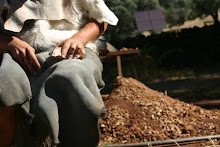
A nossa passagem pelo Congresso do WAC em Dublin levou-nos ao encontro de Sessões, trabalhos e posters bastantes interessantes. Destacamos aqui aqueles vimos relacionados com Arqueologia Experimental e Estudos Funcionais:
Experimental Archaeology
Patrick J. Gaynor
Abstract
Past archeological surveys conducted on land in Australia that had been used for broadacre cultivation, posed a number of questions for archaeologists who where trying to interpret the stone artefacts scatters recorded in those surveys. In an attempt to obtain data on artefact displacement, an experiment was set up using agricultural broadacre implements and modern stone artefacts made from raw materials that had been used by Aboriginal knappers in the past.
http://www.wac6.org/livesite/posters/poster_files/WAC_007_Gaynor.pdf
Experimental archaeology of palaeosols in the UK
Martin Bell (University of Reading, UK)
Abstract
Between 1985 and 1991 Dr Peter Reynolds established 4 octagonal experimental earthworks under the umbrella of the Butser Ancient Farm, UK: one each on Lower, Middle and Upper Chalk and one on aeolian drift. The soils below them have now been investigated 20 years after burial to examine post burial changes in terms of faunal processes, soil chemistry and the preservation of biota. This evidence can be compared to that from the linear experimental earthworks at Overton Down, Wiltshire (Upper Chalk) and Wareham Heath, Dorset (Tertiary sands) sectioned at intervals over 32 years. Comparisons highlight the unique characteristics of each site and the importance of adequate experimental replication. Decadal scale experiments are relevant because many changes to buried soils are rapid following burial, and within 10-20 years quasi-equilibrium is achieved. Thus 20- to 32-year-old buried soils are similar in appearance, and some properties, to those of prehistory.
http://www.wac6.org/livesite/precirculated/2069_precirculated.pdf
The gripping nature of ochre
Marize Lombard
Abstract
This contribution provides direct evidence for the use of ochre in adhesive recipes during the Howirsons Poort of South Africa. Stone segments from two Kwazulu-Natal sites were microscopically analysed to document ochre and resin residues.
http://www.wac6.org/livesite/posters/poster_files/WAC_012_Stene_Amundsen.pdf
Experimental Archaeology
Patrick J. Gaynor
Abstract
Past archeological surveys conducted on land in Australia that had been used for broadacre cultivation, posed a number of questions for archaeologists who where trying to interpret the stone artefacts scatters recorded in those surveys. In an attempt to obtain data on artefact displacement, an experiment was set up using agricultural broadacre implements and modern stone artefacts made from raw materials that had been used by Aboriginal knappers in the past.
http://www.wac6.org/livesite/posters/poster_files/WAC_007_Gaynor.pdf
Experimental archaeology of palaeosols in the UK
Martin Bell (University of Reading, UK)
Abstract
Between 1985 and 1991 Dr Peter Reynolds established 4 octagonal experimental earthworks under the umbrella of the Butser Ancient Farm, UK: one each on Lower, Middle and Upper Chalk and one on aeolian drift. The soils below them have now been investigated 20 years after burial to examine post burial changes in terms of faunal processes, soil chemistry and the preservation of biota. This evidence can be compared to that from the linear experimental earthworks at Overton Down, Wiltshire (Upper Chalk) and Wareham Heath, Dorset (Tertiary sands) sectioned at intervals over 32 years. Comparisons highlight the unique characteristics of each site and the importance of adequate experimental replication. Decadal scale experiments are relevant because many changes to buried soils are rapid following burial, and within 10-20 years quasi-equilibrium is achieved. Thus 20- to 32-year-old buried soils are similar in appearance, and some properties, to those of prehistory.
http://www.wac6.org/livesite/precirculated/2069_precirculated.pdf
The gripping nature of ochre
Marize Lombard
Abstract
This contribution provides direct evidence for the use of ochre in adhesive recipes during the Howirsons Poort of South Africa. Stone segments from two Kwazulu-Natal sites were microscopically analysed to document ochre and resin residues.
http://www.wac6.org/livesite/posters/poster_files/WAC_012_Stene_Amundsen.pdf

